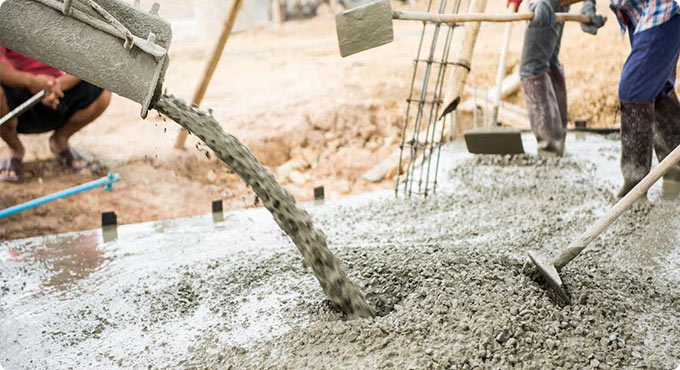The quality of concrete is affected by severe weather conditions (intense heat or cold, and humidity deviations). If concreting is done in hot weather, proper precautions should be taken to combat all the adverse effects of extreme ambient temperature.
Definition of hot weather for concreting: As per guidelines provided by American Concrete Institute (ACI) vide ACI-305R-10, hot weather means job-site conditions that speed up the rate of moisture loss or rate of cement hydration of freshly mixed concrete, along with the following:
a) Ambient temperature of 27 °C (80°F) or greater; and
b) Evaporation rate that surpasses 1 kg/m2/h
Canadian Concrete Design code (CSA A23.1/.2) employs the similar ambient temperature for hot weather (27 °C).
Challenges of Hot Weather Concreting
How concrete is impacted with hot weather: The water is a prime ingredient in concrete. When the temperature is raised, the rate of vaporization is also increased. So, adequate quantity of water is required in concrete production to cope up with hot weather condition.
The following issues are also occurred due to hot weather condition:
1- Accelerated slump loss leading to the addition of water on the job-site,
2- Increased rate of Setting resulting in placing and finishing difficulties,
3- Increased tendency for thermal and plastic cracking,
4- Critical need for prompt early curing,
5- Difficulties in controlling entrained air,
6- Increased concrete temperature resulting in long term strength loss.
Precautions for Hot Weather Concreting: These precautions should be taken throughout concrete production and delivery, and will enhance the stability performance of concrete to get rid of unwanted cracking.
1- Apply materials and mix proportions which contain good resistance capacity against hot-weather conditions.
2- Chill the concrete or one or more of its constituents.
3- The uniformity of concrete should allow quick placement and consolidation.
4- Minimize the time of transport, placing and finishing as far as possible.
5- Schedule concrete placements to control exposure to atmospheric conditions (i.e. at night or all through good weather conditions).
Common Solutions for Cooling Materials: The common process to be followed for chilling concrete is to reduce the temperature of the concrete materials prior to start of mixing.
The aggregates and mixing water should be retained as cool as possible since these materials significantly affect the concrete temperature after mixing as compared to other materials. In severe hot condition, a segment of water is substituted with ice to reduce the temperature. Curing of concrete is vital for decreasing the adverse effects of hot weather on the quality of concrete.

Read more
~~~~~~~~~~~~~~~~~~~~~~~~
Published By
Rajib Dey
www.constructioncost.co
~~~~~~~~~~~~~~~~~~~~~~~~
Definition of hot weather for concreting: As per guidelines provided by American Concrete Institute (ACI) vide ACI-305R-10, hot weather means job-site conditions that speed up the rate of moisture loss or rate of cement hydration of freshly mixed concrete, along with the following:
a) Ambient temperature of 27 °C (80°F) or greater; and
b) Evaporation rate that surpasses 1 kg/m2/h
Canadian Concrete Design code (CSA A23.1/.2) employs the similar ambient temperature for hot weather (27 °C).
Challenges of Hot Weather Concreting
How concrete is impacted with hot weather: The water is a prime ingredient in concrete. When the temperature is raised, the rate of vaporization is also increased. So, adequate quantity of water is required in concrete production to cope up with hot weather condition.
The following issues are also occurred due to hot weather condition:
1- Accelerated slump loss leading to the addition of water on the job-site,
2- Increased rate of Setting resulting in placing and finishing difficulties,
3- Increased tendency for thermal and plastic cracking,
4- Critical need for prompt early curing,
5- Difficulties in controlling entrained air,
6- Increased concrete temperature resulting in long term strength loss.
Precautions for Hot Weather Concreting: These precautions should be taken throughout concrete production and delivery, and will enhance the stability performance of concrete to get rid of unwanted cracking.
1- Apply materials and mix proportions which contain good resistance capacity against hot-weather conditions.
2- Chill the concrete or one or more of its constituents.
3- The uniformity of concrete should allow quick placement and consolidation.
4- Minimize the time of transport, placing and finishing as far as possible.
5- Schedule concrete placements to control exposure to atmospheric conditions (i.e. at night or all through good weather conditions).
Common Solutions for Cooling Materials: The common process to be followed for chilling concrete is to reduce the temperature of the concrete materials prior to start of mixing.
The aggregates and mixing water should be retained as cool as possible since these materials significantly affect the concrete temperature after mixing as compared to other materials. In severe hot condition, a segment of water is substituted with ice to reduce the temperature. Curing of concrete is vital for decreasing the adverse effects of hot weather on the quality of concrete.

Read more
~~~~~~~~~~~~~~~~~~~~~~~~
Published By
Rajib Dey
www.constructioncost.co
~~~~~~~~~~~~~~~~~~~~~~~~
No comments:
Post a Comment